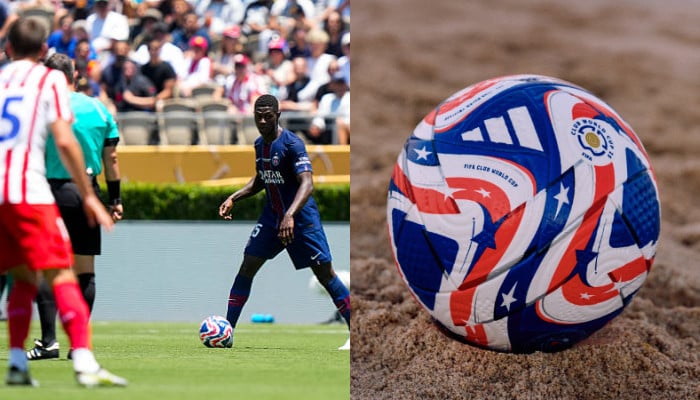Spotlight on Pakistan-Made Ball at FIFA Club World Cup
As the FIFA Club World Cup commences in the United States, attention is directed not only at the competing teams but also at the official ball.
Adidas recently introduced the FIFA Club World Cup 25 Pro Ball. Beyond its eye-catching stars-and-stripes design, the ball is notable for its exceptional performance and sophisticated engineering, particularly as it is made in Pakistan.
Sam Handy, Adidas’ general manager for football, stated that the ball is the result of 18 months of detailed development, with the goal of creating a product that is “bold, loud, iconic—and unmistakably American.”
However, its patriotic appearance belies the superior manufacturing capabilities and advanced engineering present in Pakistan.
Innovative Design and Materials
The 2025 Club World Cup ball is made from 61% polyurethane, 30% recycled polyester, and 9% viscose, a shift toward sustainability, unlike earlier iterations made entirely of polyurethane.
It also incorporates Adidas’ PRECISIONSHELL technology — a thermally bonded structure composed of 20 panels with deliberately placed debossed grooves to optimize airflow and improve flight stability.
This production is carried out in Pakistan, where most of the world’s soccer balls are manufactured.
Performance Testing and Results
The ball’s superior performance was confirmed through testing at Loughborough University, a respected sports research institution in the UK.
Researchers used both human players and a robotic mechanism to evaluate the new Adidas ball against models from the Premier League (Nike Flight), Carabao Cup (Puma Orbita 1), and FA Cup (Mitre Ultimax Pro).
While robot testing revealed comparable speed and spin across all models, player testing showed “noticeable differences,” according to Professor Andy Harland, who oversaw the study.
Players achieved their fastest strikes and higher spin rates with the Club World Cup ball. One player even doubled the spin compared to the Nike ball. One player noted that the ball “hits truer for professionals,” indicating that its design is suited for high-level, precision-based play.
Players found that the ball felt firmer and had a smaller sweet spot, necessitating more precise contact. However, they valued its consistency during open play, especially for accurate long ground passes.
Despite the small sample size, all three players recorded their fastest strikes using the Club World Cup ball. “It hits truer for the professionals,” one player commented afterward.
“You had to hit it more precisely,” the players observed, noting that the Club World Cup ball has a smaller ‘sweet spot’ compared to others.
Conversely, robot testing—which Harland explained “should give a near-identical kick each time” due to the “fixed” leg speed and ball placement—did not identify the Club World Cup ball as the fastest.
The players also described the unique feel when striking the ball: “Especially the Adidas (Club World Cup) ball, that felt rock-hard,” one player said. “It has no grip. Because you have the little grooves, you spin it more,” another added.
Two players agreed on its strengths: “Probably better in open play. It would be good to hit a long pass with, a grasscutter (a long pass, kept low to the floor) would be perfect.”
All the balls were manufactured in Pakistan. The special construction of the Club World Cup edition explains the differences players notice when kicking it.
According to Adidas, the high-grade butyl bladder inside the ball helps maintain shape and flight stability. The company guarantees the ball’s shape for two years due to its confidence in its durability.
The ball also features a motion sensor, which transmits data 500 times per second to assist in semi-automated offside calls, player tracking, and touch-point identification, demonstrating the integration of sports and smart technology.
Evolution of Football Technology
While this is not Adidas’ first venture into high-tech footballs, the Club World Cup 25 Pro Ball represents a major advancement from earlier models such as the Fevernova from the 2003 Women’s World Cup and the Questra from the 1994 tournament.
In the past, balls were hand-stitched and constructed from a variety of materials. Since 2004, Adidas has adopted thermal bonding, and the new panel designs now enable unprecedented aerodynamic accuracy.
According to Ieuan Williams, the testing lead at Loughborough, ball design has progressed to the point where aerodynamics are prioritized over symmetry.
“People started to go, ‘Well, these don’t have to be regular shapes any longer. We can do crazy things with panels’,” he says. “There’s been a bit of a readjustment, and now we need to make sure that the ball flies properly again, which has made a load of investment in that.”
Ultimately, Adidas has departed from the tradition of simply repainting an existing model. The Club World Cup ball is not merely a visual upgrade; it is a technical overhaul designed for modern football.
With 63 matches scheduled, the ball’s actual performance will be closely monitored. However, initial indications suggest that this marvel made in Pakistan is ready to perform at the highest level.



Comments (0)
No comments yet. Be the first to comment!
Leave a Comment